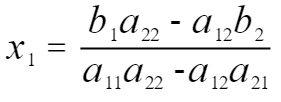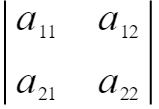In high school we have learned a simple set of linear equations, which leads us determinant concept:
Assumed that there equations:
a 11 x 1 + a 12 x 2 = b 1 , ... (1)
a21x1 + a22x2 = b2 ,… (1)
Erasing unknowns X 2 : (. 1) ✖ A 22 is - (2) ✖a 12 is obtained
(a11a22 -a12a21) x1 = b1a22 - b2a12
Similarly eliminate unknowns x1:
(a11a22 -a12a21) x2 = b2a11 - b1a21
Can be found: A . 11 A 22 is -a 12 is A 21 is ≠ 0,
Solutions to equation is:


From the above equations can be found in both the numerator and denominator are the difference between the number of four teams of the product, where the denominator A . 11 A 22 is -a 12 is A 21 is equations as unknowns coefficient group determined. Time being four in number according to the relative position of this sort equations, tables are arranged in two rows and two columns, as follows:

The above expression is a number of tables: A . 11 A 22 is -a 12 is A 21 is
The determinant is called second order form, the table number representing said second order of 2 rows and 2 columns whose elements Location determined position of rows and columns.
A ij of , I represents the number of rows, j represents the number of columns. The A . 11 and A 22 is a main diagonal line connecting referred to, A 21 is A 12 is a diagonal line connecting referred to as secondary, reference may be (cross Multiplication)
Then the solution x unknowns can be written as: x = D1 / D
D is the determinant, D1 1 is replaced determinant row elements as unknowns.